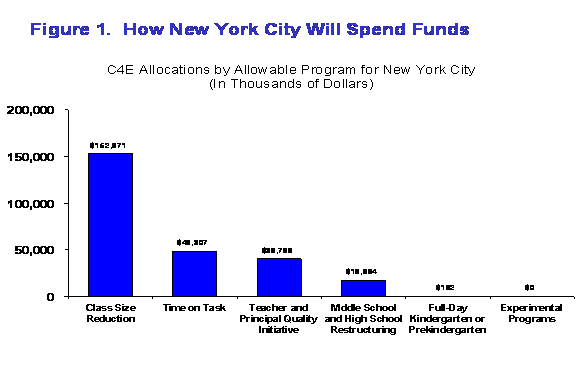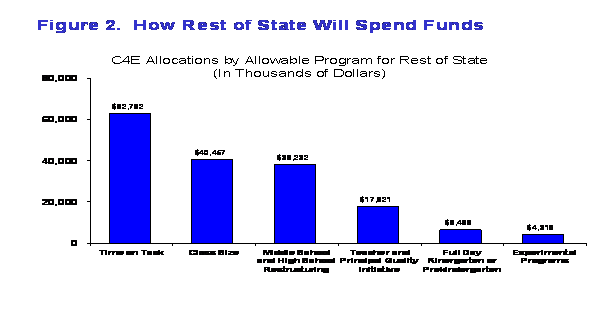Meeting of the Board of Regents | December 2007
|
|
THE STATE EDUCATION DEPARTMENT / THE UNIVERSITY OF THE STATE OF NEW YORK / ALBANY, NY 12234 |
|
TO: |
|
|
FROM: |
Johanna Duncan-Poitier
|
|
SUBJECT: |
Update on Contracts for Excellence |
|
DATE: |
November 29, 2007 |
|
STRATEGIC GOAL: |
1, 2, 3 and 5 |
|
AUTHORIZATION(S): |
|
SUMMARY
Issue for Discussion
How will school districts spend their Foundation Aid increase subject to Contract for Excellence requirements? What are the next steps in implementation of the Contracts?
Reason(s) for Consideration
Review of policy.
Proposed Handling
This information will be shared and discussed with the Regents EMSC-VESID Committee in December.
Procedural History
The 2007-08 State budget required specific school districts to enter into contracts for excellence and to spend a portion of their Foundation Aid increase for school year 2007-08 on certain allowable programs and activities. To facilitate the successful implementation of the contracts for excellence for the 2007-08 school year, as required by statute, the Regents adopted regulations by emergency action at their April 2007 meeting. Contract proposals were submitted by school districts in July 2007 and the Department reviewed them all by August 15, 2007. The Department worked extensively with the Contract districts to revise and refine the proposals so that statutory and regulatory requirements were met. The Commissioner approved all final Contracts for Excellence on November 19, 2007.
Background Information
The Board of Regents has long advocated for simplification of the school funding formula, adequate school funding and strengthened accountability concerning the use of State Aid to school districts. Under Board of Regents direction, the Department developed a state accountability system that has been consistently praised as the best in the nation and which preceded a similar federal accountability system.
The 2008-09 State budget (Chapter 57) provided a tremendous opportunity to invest resources in new and innovative ways to help all students achieve greater success. The Contracts for Excellence are one component of the State Aid provisions of Chapter 57. Chapter 57 authorized the Commissioner of Education to establish allowable programs and activities, criteria for public reporting by school districts of their total Foundation Aid expenditures, and other requirements for the preparation of Contracts for Excellence by certain school districts.
The Department worked extensively with the field in developing the implementation regulations for the Contracts for Excellence and the Web-based process for submission of the Contracts. To facilitate the preparation and submission of the Contract proposals, the Regents adopted regulations by emergency action within weeks of final passage of the State budget. Subsequent actions have been taken by the Regents to revise and adopt the regulations so that school districts could meet their statutory obligations under the State budget.
In July 2007, all 55 Contracts for Excellence were submitted to the Department and were reviewed by the target date of August 15th. At that time, Department staff advised most Districts that they were on the right path, however, a number of districts’ proposed contracts required additional development and refinement (particularly those from the larger school districts). Between August 15th and November 16th, the Department worked extensively with the Contract districts to revise and refine their proposals so that they would meet both the statutory requirements and the regulatory requirements the Regents had established. These discussions involved planned expenditures for more than 1, 500 schools and impacting upon more than a million students. On November 19th, Commissioner Mills formally approved all 55 Contracts for Excellence. A public event was held in Buffalo, New York on November 19th, announcing the approval of the Contracts. This event was attended by Governor Eliot Spitzer, members of the New York State Legislature, members of the Board of Regents, Commissioner Mills, Senior Deputy Commissioner Duncan-Poitier, and a number of Superintendents from Contract districts.
Now that the Contracts have been approved, the implementation and monitoring process begins; as well as plans for the next round of Contracts. This item outlines how the 55 Contract districts plan to use their Contract funds and what the next steps are in the implementation and monitoring process.
Recommendation
N/A
Timetable for Implementation
N/A
Contracts for Excellence
Overview
On Monday, November 19, Governor Spitzer, members of the New York State Legislature, members of the Board of Regents and the Commissioner announced the approval of this year’s Contracts for Excellence in Buffalo. The approved Contracts for Excellence were also posted on the Department’s Website at www.emsc.nysed.gov/mgtserv/C4E/.
While all school districts in New York State received increases in their Foundation Aid this year, fifty-six districts , including New York City, were required to enter into a Contract for Excellence, describing how they will use a portion of their Foundation Aid to further increase student achievement in their district. Districts were identified as “Contract Districts” if they received at least a 10 percent increase in Foundation Aid and had at least one school requiring academic progress, in need of improvement, in corrective action, or in restructuring status (Attachment A). Consistent with the direction of the Board of Regents, Contract districts agreed to:
- Direct 75 percent of the funds to the neediest students.
- Use proven programs in the following categories:
-
- Time on Task - More time in school, and more focused instruction to help individual students
- Better recruiting and professional development for teachers
- Pre-kindergarten or kindergarten
- Restructuring of middle and high schools
- Class size reduction
- Set targets showing the improvement they expect, including all students in need and groups of students, such as students with disabilities or English Language Learners.
- Use the money in proportion to the needs of students in low-performing schools before spending dollars on other schools.
- Publicly report results and have a complaint process in preparation for public hearings that will be required.
The 55 Contract districts used their C4E dollars in 1,547 schools that have an enrollment of almost 1.1 million students. Attachment B is a chart that shows how many schools in C4E districts have C4E-funded programs in each approved category. The Contracts account for a total of $428 million in State funding for schools.
Contract proposals were submitted to the Department in July and were all reviewed by the August 15th target date set by the Department. The Department worked with the Contract districts to ensure that all Contracts met the statutory and regulatory requirements. Changes were necessary in some Contracts to:
- reallocate funds to ensure 75 percent flowed to the students most in need;
- reallocate funds to ensure the amount of money was commensurate with the need in specific schools; and
- set performance targets for each school.
Contract Expenditures – New York City Department of Education
Chapter 57 required that the New York City Contract include a separate five-year plan for class size reduction. The Commissioner approved both New York City’s overall contract and its class size plan. New York City has further agreed to extend and amend its plan to cut class sizes in all of New York City's overcrowded and low-performing schools, subject to approval by the Commissioner.
The approved NYC DOE plan provides:
- Baseline class size data for every school to measure progress over time.
- An overall 5-year class size reduction plan for the entire City.
- Established class size targets for the most severely overcrowded and low-performing schools – those with class sizes of 29 or above – that will reduce class sizes to the citywide average.
- Established performance targets for all Contract for Excellence schools.
Figure 1 shows that New York City will spend more than half ($152 million) of their Foundation Aid increase subject to Contract for Excellence requirements for class size reduction. Of this amount, the City allocated approximately $78 million to put an additional teacher in a classroom and approximately $51 million for teachers in new classrooms. The City allocated the balance of approximately $23 million to continue existing class size reduction programs, as allowed under the legislation.
The City District allocated the remainder of their C4E contract amount as follows, approximately:
- $48 million to increased time on task for students including a longer school day, dedicated instructional time during the school day and individualized tutoring.
- $40 million to teacher and principal quality initiatives including programs to recruit and retain highly qualified teachers, instructional coaches for teachers and principals and professional mentoring for beginning teachers and principals.
- $13.5 million for district-wide initiatives,
- $3.4 million to continue existing programs as allowed in the legislation,
- $36 million for new or expanded programs in schools,
- $17 million for middle and high school restructuring, and
- $182,000 for full-day kindergarten and pre-kindergarten programs.

Contract Expenditures – Rest of State
Figure 2 shows that the other 54 Contract for Excellence districts in the rest of the State allocated approximately:
- $63 million of $170 million of their Foundation Aid increase subject to Contract requirements to increase student time on task. Time on task initiatives for these districts include dedicated instructional time, individualized tutoring, lengthened school day and lengthened school year.
- $9 million to continue existing programs as allowed by the law,
- $8 million for district-wide initiatives,
- $40 million to class size reduction,
- $13 million each for an additional teacher in the classroom and for teachers in new classrooms,
- $14 million to continue existing programs, as allowed in the law,
- $38 million to middle school and high school restructuring mostly to implement instructional improvements and different grade configurations,
- $18 million to teacher and principal quality initiatives,
- 6.5 million to full-day kindergarten and pre-kindergarten, and
- $4.3 million for experimental programs.

Examples of Contract Programs
Contract for Excellence funds are supporting a number of cutting edge, new and continuing programs and initiatives across the 55 school districts.
Increased Time on Task
In order to increase time on task, C4E funds will enable roughly ¼ of Buffalo’s schools to lengthen their school days by 1 hour from 6 ½ to 7 ½ hours of instruction per day.
Other significant interventions funded by the C4E under the rubric of time on task, include evening hour accessibility for computer rooms and libraries in East Irondequoit to provide access to these needed resources to both students and their parents.
In New York City Community School District 9, approximately $1,234,917 of C4E funds will be expended during 2007-08 to implement longer day. This will allow the expansion of before/after-school and weekend instructional programs and individualized tutoring sessions for the 2007-08 school year. It will create additional opportunities for the provision of Academic Intervention Services (AIS) to meet the needs of all students K-12 who require additional assistance to meet the State standards in ELA, mathematics, science, and social studies.
Middle and High School Restructuring
Some of the more unique educational programs that school districts are undertaking with Contract for Excellence funding relate to structural reforms of the middle and high school grades. For example:
- In Rochester a gateway program will enable high school dropouts to enroll in a dual credit program to earn both a high school diploma and college credits.
- The Arlington school district is using C4E funds in part to establish Project Lead the Way, an innovative program to introduce high school students to science, technology and engineering topics and careers.
- Yonkers has created a new school, the Riverside High School of Engineering and Design which will have an increased focus on mathematics and its relevance to the environment and engineering.
- Newburgh will be establishing a construction careers academy and many other districts, including Carthage, will be creating small learning communities and 9th grade academies to ease the transition to high school and prepare these pupils for the rigor of a challenging pre-college academic program.
Teacher and Principal Quality Initiatives
The research is very clear that improving teacher quality is perhaps the strongest policy lever that schools have to improve achievement and C4E districts are making significant efforts in this regard. The C4E plan of South Colonie is illustrative: their new teacher orientation ensures a common teaching methodology across all subjects and grade levels. Furthermore, a strong peer mentor program affords new teachers the opportunity to work with seasoned veterans, who provide ongoing support as new teachers develop in the early years of the profession.
In New York City’s Community School District 1, $49,643 in CFE funds will be expended during 2007-08 to support the training and the development of inquiry teams. All CSD1 schools will be engaged in Children First Intensive, a year-long cycle of training and professional development to embed the practice of evidence-based individualized instruction, self-evaluation, and continuous improvement in every school. In addition, $5,984 will be expended for mentoring and $83,296 to recruit and retain teachers as well as for other school-based professional development initiatives to support teachers with specialized strategies to meet the needs of struggling students.
Class Size Reduction
Research has shown that reductions in class size, particularly in the early grades can improve student academic achievement. More than three-quarters of Contract for Excellence districts are using at least part of their fund allocations to support these efforts. For example, the UFSD Tarrytowns district will be targeting their efforts on the early grades, achieving a 15 percent reduction in class size for kindergarten and 1st grade. The Rochester City School District will also target the early grades with the intent of effecting the greatest reductions in the core subject areas. In the Newburgh City School District, fourteen new classrooms will be built in two schools, resulting in a reduced class size across the district over three years to 20 students per class.
Full-day Pre-k and Kindergarten
C4E funds allowed districts to expand or continue efforts already underway. For example, in White Plains the C4E funds allowed an existing half-day pre-kindergarten program to expand to a full day for those students most in need.
Other Initiatives
Technology and data analysis is an important and inherent part of a number of districts’ Contract for Excellence plans. For example, Hyde Park is creating a research and development committee which will conduct action research projects and share their results with staff in order to drive instructional practices based on their effectiveness in the classroom. And the Fulton City School District will create the position of district data administrator with C4E funds, to provide data analysis, evaluation and professional development so that data-based decision making supports learning and instruction.
Finally some of the more innovative uses of C4E funds relate to making those investments which will treat the social, behavioral and emotional growth of pupils. The Arlington school district will use C4E funds for character education and in Rochester; an on-campus intervention program in a number of schools focuses on reducing suspensions by referring students to an academic and counseling program to help address their educational, social and emotional needs.
Next Steps
- Feedback from Impacted Districts:
A meeting will be held on December 19 with this year’s Contract for Excellence superintendents to evaluate the system and identify improvements for next year. For example, we will look at enhancing the Internet-based C4E system to include a reporting capability to facilitate the sharing of district Contracts once they are submitted. We will incorporate into the system the reporting of performance targets required for each school receiving funds subject to C4E. We will share guidance on preparing for the C4E process, including standards for approving 2008-09 Contracts. We will identify topics for further discussion and groups of Superintendents to develop these topics together with SED staff.
- Final Regents Regulations on C4E
Amendments to the regulations on Contracts for Excellence, based upon the policy direction of the Board of Regents, public comment and our experience in implementing the Contracts this year are being drafted for consideration by the Regents in January. These revisions will clarify standards for development and approval of future Contracts for Excellence.
- Clarification for the Field
Many important concepts in the C4E process, such as assessing educational need, targeting resources predominately to students with the greatest educational needs, and defining what constitutes maintaining existing district programs, need further discussion, development and clarification.
- Class Size Panel
The regulations require that the Commissioner appoint a panel to make recommendations regarding standards for classroom teacher-student ratios for prekindergarten through grade 12. The panel will examine research, hear from experts, and seek advice of parents, teachers, and school leaders. The Commissioner will review their work and make recommendations for class size standards, as required by the statute and regulation. New York City has agreed to amend their five-year Class Size Reduction plan in accordance with the Commissioner’s standards.
- Coordinated Monitoring
The Department staff will describe to the Committee in December the plans for coordinated monitoring visits that will occur in the spring and that will include the C4E districts. Monitoring efforts will involve SED staff, District Superintendents and Regional School Support staff in assessing whether districts implemented C4E plans as proposed, that a public process was in place as required by law, that districts have an accounting system to account for the expenditure of Foundation Aid subject to C4E requirements, and that districts have a complaint process in place for the public to comment on each district’s C4E plan. After consultation with the Board of Regents, we will develop the evaluation of C4E programs with C4E superintendents and representatives of the Education Finance Research Consortium.
- SED Capacity
Efforts to hire additional staff are continuing and will increase our capacity to further develop the C4E system, assist districts in preparing contracts, and coordinate intra-departmental efforts to implement the contracts, measure progress and ensure accountability.
- C4E Performance Data
Staff is analyzing performance data to guide efforts to assist districts in making changes to their Contracts for Excellence for next year. The Department will clearly communicate accountability requirements to existing and potential C4E districts, including:
- C4E districts are fiscally and programmatically accountable for expending contract funds in accordance with their approved plans and SED will monitor district adherence to their plans.
- C4E districts are accountable for achieving performance targets established in their plan related to improving the performance of students with the greatest educational need. Attainment or lack of attainment of these targets will be assessed in monitoring and influence how future contract funds may be used.
- C4E districts are accountable for ensuring that the district and its schools make Adequate Yearly Progress. Schools and Districts must cooperate with School Quality Review Teams, Joint Intervention Teams, and Distinguished Educators who may be assigned to assist and/or oversee the development and implementation of improvement plans. The Department will work closely with those schools and districts that need additional support using research-based strategies to improve student achievement.
Attachment A
District Allocations
Chapter 57 of the laws of 2007
One school district, Albany, received more than the 10 percent increase in Foundation Aid [almost $6 million]; however, because of the projected 2007-08 increase in the Albany City School District’s charter school tuition payments, the District was exempted from the requirement to submit a Contract for Excellence for the 2007-08 school year. The statute, (Education Law §211-d(2)), allows school districts to deduct increases in basic charter school tuition from the amount of Foundation Aid that would be covered by the Contracts for Excellence requirements. The Albany City School District’s increase in charter school tuition payments reduced the amount of the District’s Foundation Aid covered by the Contracts for Excellence provisions to zero.






